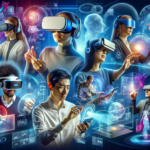Immersive corporate training: The Impact of Immersive Technologies in Corporate Training and Onboarding 🚀
Introduction to Immersive Technologies
In an era of rapid technological advancement, **immersive technologies** such as Virtual Reality (VR), Augmented Reality (AR), and Mixed Reality (MR) are revolutionizing the way we approach corporate training and onboarding. These innovative tools provide an engaging, interactive environment that enhances the learning experience. As businesses strive to keep pace with the fast-changing landscape of their industries, the adoption of immersive technologies becomes not just beneficial but essential.
The Importance of Effective Corporate Training
Effective corporate training and onboarding are crucial for several reasons:
- Faster Skill Acquisition: Employees need to acquire new skills quickly to adapt to their roles.
- Greater Employee Engagement: Engaging training programs reduce turnover and foster loyalty.
- Cost Efficiency: A well-trained workforce reduces errors and increases productivity.
Incorporating immersive technologies into these processes addresses these needs effectively while also elevating the quality of training programs.
What Are Immersive Technologies?
Immersive technologies create lifelike simulations or augmentations that enhance the user’s experience. Here are the primary types:
1. Virtual Reality (VR)
Virtual Reality immerses participants in a fully digital environment. Using VR headsets, employees can explore scenarios, practice skills, and interact with virtual objects aimed at enhancing their learning experience.
2. Augmented Reality (AR)
Augmented Reality overlays digital information onto the real-world environment, allowing trainees to engage with both physical and virtual elements simultaneously. This technology is particularly useful for hands-on training.
3. Mixed Reality (MR)
Mixed Reality merges the physical and virtual worlds, enabling users to manipulate digital objects as if they were real. This can deepen understanding of complex concepts and processes in a corporate setting.
immersive corporate training: Enhancing Training Programs with Immersive Technologies
The integration of immersive technologies into training programs offers several powerful benefits:
1. Increased Engagement and Motivation
Experiential learning captivates attention. Interactive scenarios provide employees with unique experiences that traditional methods simply cannot match. Facilitating engagement not only stimulates learning but also increases retention rates.
- Gamification: Adding game-like elements, such as points and achievements, encourages competition and boosts motivation.
- Real-World Simulation: Training in a simulated environment allows employees to practice skills without real-world consequences.
2. Enhanced Knowledge Retention
Studies show that immersive experiences lead to superior knowledge retention. When learners actively participate, rather than passively receive information, they are likely to remember what they’ve learned. This **active learning approach** fosters deeper understanding and promotes long-term memory.
3. Customized Learning Paths
Immersive technologies allow organizations to facilitate tailored training experiences. Employees can engage with content at their own pace, focusing on areas where they need improvement.
- Adaptive Learning: Algorithms can suggest content based on employee performance, ensuring that resources are directed where needed most.
- Varied Formats: Users can experience videos, simulations, and interactive tasks, catering to different learning styles.
Real-World Applications of Immersive Technologies
Reflecting on various successful implementations can inspire organizations to adopt these transformative technologies:
1. Pharmaceutical Industry
In the pharmaceutical sector, organizations utilize VR to train employees on compliance protocols, equipment handling, and emergency procedures without risk to actual patients. Through immersive simulations, staff can familiarize themselves with real-world challenges.
2. Manufacturing and Engineering
Manufacturing companies often use AR to guide technicians through complex assembly processes. Workers can access real-time data without looking away from their tasks, streamlining workflows and reducing mistakes.
3. Retail Sector
Retail chains are leveraging immersive technologies for training customer service representatives. VR simulations allow employees to practice handling difficult customer interactions, enhancing their interpersonal skills in a controlled setting.
Challenges and Considerations
While the benefits of immersive technologies in training are immense, organizations must remain aware of potential challenges:
- Cost of Implementation: Initial investments in immersive technologies can be substantial, especially for smaller businesses.
- Technology Compatibility: Ensuring that the new systems integrate seamlessly with existing infrastructure is vital for effective implementation.
- Training Requirements for Trainers: Staff delivering training using these technologies need specific skills to maximize the effectiveness of the tools.
The Future of Corporate Training and Onboarding
The future is bright as companies increasingly realize the value of immersive technologies. As advancements in AR and VR continue to emerge, integrating these tools into corporate training programs will enhance the overall learning experience more profoundly. Organizations will likely:
- Embrace AI Integration: Future training programs may combine artificial intelligence with immersive experiences, personalizing learning pathways to an unprecedented degree.
- Expand Global Training Opportunities: Remote teams can engage in immersive training experiences that foster collaboration across borders, breaking geographical barriers.
In summary, the power of immersive technologies has the potential to redefine corporate training and onboarding, leading to more effective, engaging, and personalized learning experiences. By embracing these innovative solutions, companies can ensure their workforce is equipped with the skills and knowledge necessary for success in today’s rapidly evolving business landscape.




0 Comments